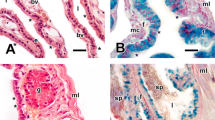Summary
-
1.
The California race of Icerya purchasi comprises only protandric hermaphrodites and males. There exist no pure females.
-
2.
There is never any trace of parthenogenetic development of the eggs. Each egg must be fertilized by a spermatozoon in order to initiate development.
-
3.
The eggs are usually fertilized by spermatozoa from the hermaphrodite's own testes; that is, the hermaphrodites are self-fertilizing.
-
4.
Self-fertilized hermaphrodites give rise to hermaphrodites only.
-
5.
Cross-fertilized hermaphrodites, i. e., those that have copulated with males, may give rise to broods of hermaphrodites only, or to mixed broods containing a small proportion of males.
-
6.
It is therefore suggested that only in the rare instances when a male-producing spermatozoon from a pure male succeeds in fertilizing an egg in competition with the hermaphroditically produced spermatozoa docs a pure male result.
-
7.
The morphology and histology of the hermaphroditic gonad is described for each of the nymphal and adult instars.
-
8.
The somatic and oogonial chromosome number in the hermaphrodites is four. The eggs undergo a normal maturation. Two tetrads are evolved and two polar bodies given off, thus reducing the chromosome number to two. No indication of the peculiar behaviour reported by Pierantoni in the maturing egg was found.
-
9.
Many entire spermatozoa enter each egg, and evolve nuclei which show the haploid chromosome group. These nuclei develop no further unless union with the female pronuclcus takes place. Fusion of the female pronucleus with one of the male pronuclei may take place at any point between the periphery and the center of the egg.
-
10.
In the eggs of self-fertilized hermaphrodites, i. e., those which had been isolated from males since birth, and in the eggs of cross-fertilized hermaphrodites which had copulated with males, the processes of oogenesis and fertilization arc exactly the same. There is no way to distinguish the spermatozoa of the hermaphrodite from those of the true male in fertilization.
-
11.
Spermatogenesis is in every respect the same in the testes of male and of hermaphrodite. The somatic and spermatogonial chromosome number is four. Two tetrads are evolved and a normal reduction takes place. The cytoplasmic division is invariably suppressed during the second maturation division, and may also sometimes be absent during first division. Thus two kinds of spermatids are produced, binucleate and quadrinucleate, whose components separate upon reaching maturity.
-
12.
Incidental observations confirm Pierantonis claim that the mycetocytes in Icerya arise from simple cleavage cells.
Similar content being viewed by others
References
Aßmuth, J. (1913): Termitoxenia assmuthi Wasmann — Anatomisch-histologische Untersuchung. Nova acta acad. Leop. Carol., Halle, 98.
— Ders. (1923): Ametabolie und Hermaphroditismus bei den Termitoxeniiden (Dipt.). Biol. Zentralbl. 43.
Bělar, K. (1924): Die Cytologie der Merospermie bei frei lebenden Rhabditis-Arten. Zeitschr. f. wiss. Biol., Abt. f. Zellen- u. Gewebelehre 1.
Berlesi, A. (1909): Gli Insetti. 1: Embriologia e Morfologia. Soc. ed. lib., Milan.
Brues, C. T. (1901): Two new myrmecophilous genera of aberrant Phoridae from Texas. Americ. naturalist 35.
Bugnion, E. (1913): Termitoxenia-Etude anato-histologique. Ann. de la soc. entomol. de Belgique 57.
Emeis, W. (1915): Über Eientwicklung bei den Cocciden. Zool. Jahrb., Abt. f. Anat. 39.
Goldschmidt, R. (1923): The mechanism and physiology of sex determination. New York: Geo. H. Doran Co.
Johnston, C. E. (1912): Internal anatomy of Icerya purchasi. Ann. of the entomol. soc. of America 5.
Junker, H. (1923): Cytologische Untersuchungen an den Geschlechtsorganen der Halbzwittersteinfliege, Perla marginata. Arch. f. Zellforsch. 17.
Keilin, D. (1916): Sur la viviparité chez les Diptères et sur les larves des Diptères vivipares. Arch. de zool. exp. et gén. 55.
Krüger, E. (1913): Fortpflanzung und Keimzellenentbildung von Rhabditis aberrans n. sp. Zeitschr. f. wiss. Zool. 105.
Kuwana, I. (1922a): Studies on Japanese Monophlebinae. Contrib. 1. The genus Warajicoccus. Departm. of agric. and com. imp. plnt. quar. sta., bull. no. 1.
— Ders.: Contrib. 2. The geuus Icerya. Ebenda, bull. no. 2.
Leonardi, G. (1920): Monografia delli Cocciniglie Italiane, Stab. tip. Ernesto della Torre.
Nachtsheim, H. (1913): Cytologische Studien über die Geschlechtsbestimmung bei der Honigbiene (Apis mellifica L.). Arch. f. Zellforsch. 11.
Pierantoni, U. (1910): La simbiosi ereditaria e la biologia sessuale d'Icerya. Monit. zool. ital., anno 21.
— Ders. (1912): Studio sullo sviluppo d'Icerya purchasi mask. Parte 1. Origine ed evoluzione degli elementi sessuale femminili. Arch. di zool. ital. 5.
— Ders. (1914a): Desgl. Parte 2. Origine ed evoluzione degli orgam sessuale maschili. — Ermafroditismo. Ebenda 7.
— Ders. (1914b): Desgl. Parte 3. Osservazioni di embriologia. Ebenda 7.
Pflüger, E. (1903): Über die jungfräuliche Zeugung der Bienen. Pflügers Arch. f. d. ges. Physiol. 99.
Riley, C. V. (1886): Icerya purchasi. Ann. report of U. S. entomol.
Schleip, W. (1911): Das Verhalten des Chromatins bei Angiostomum (Rhabdonema) nigrovenosum. Arch. f. Zellforsch. 7.
Schönemund, E. (1912): Zur Biologie und Morphologie einiger Perla-Arten. Zool. Jahrb., Abt. f. Anat. 34.
Schrader, F. (1923a): A study of the chromosomes in three species of Pseudococcus. Arch. f. Zellforsch. 17.
— Ders. (1923b): The sex ratio and oogenesis of Pseudococcus citri. Zeitschr. f. indukt. Abstammungs- u. Vererbungsl. 30.
— Ders. (1923c): The origin of mycetocytes in Pseudococcus. Biol. bull. 45.
Silvestri, F. (1920): Contribuzione alla conoscenza del Termitidi e Termitofili dell' Africa occidentale. II. Termitofili. Boll. laborat. zool. gen e agrar., Portici.
Stebbing, J. O. (1904): On the life history of a new Monophlebus from India. Journ. of the Linnean soc., London 29.
Wasmann, E. (1900): Termitoxenia ein neues flügelloses, physogastres Dipterengenus aus Termitennestern. 1. Teil: Äußere Morphologie und Biologie. Zeitschr. f. wiss. Zool. 67.
— Ders. (1901): Desgl. 2. Teil. Ebenda 70.
Author information
Authors and Affiliations
Rights and permissions
About this article
Cite this article
Hughes-Schrader, S. Cytology of hermaphroditism in Icerya purchasi (Coccidae). Z.Zellforsch 2, 264–290 (1925). https://doi.org/10.1007/BF00376393
Received:
Published:
Issue Date:
DOI: https://doi.org/10.1007/BF00376393




